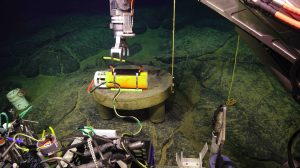Bill Chadwick
Wednesday, September 16, 2020

Another busy week has rolled by on R/V Thompson while we work out here at Axial Seamount. After being prevented from diving with Jason and Sentry for several days last week due to high winds, the weather finally subsided and we were able to get back in the water. ROV Jason’s third dive of this cruise (#1295) was a marathon that lasted over 4 days, and it accomplished several of our major goals. First, we were able to recover the three crustal compliance instruments being tested by Dr. Spahr Webb and his team (deployed on the previous dive). This involved sending a float pack to the bottom, having Jason attach lines between the float , the instrument and its cover, and then releasing the package from its descent anchor to be recovered by the ship at the surface.

Following this operation, we began our benchmark pressure survey. A precise pressure sensor was attached to Jason for this dive, so that we could measure the pressure on each of ten seafloor benchmarks scattered around the caldera. To do all that, Jason drives between the benchmarks and makes repeated measurements which help make them as precise as possible, determining the depth of each benchmark to about 1 cm. We use these readings to see how much the seafloor has risen or fallen from the previous survey and this tells us precisely how much the volcano has inflated in the last two years. Between eruptions, Axial Seamount inflates like a balloon, as magma is fed into it from below where it is stored in a reservoir 1-3 km below the seafloor. The seafloor is pushed upward by that stored magma at rates of 15-70 cm per year. We use the information from the pressure surveys to model where the magma is stored and at how it moves, as well as to try to forecast when the next eruption will occur (we think it is still a few years off right now.

At the end of the dive, we visited Vixen and Casper vents to sample the hot hydrothermal fluid gushing out of the seafloor there for chemical analysis. These two vents are a peculiar type that are full of gas and have few dissolved metals, and so they build small anhydrite chimneys, that are weak and crumbly and grow back quickly. These type of vents are scattered at several locations around the rim of the summit caldera. They differ from vents that build large chimneys of sulfide minerals, where the fluids are full of dissolved metals that build the large and durable chimney structures. At Vixen, we measured a temperature of 323°C and a temperature probe that we recovered from the vent showed that it had remained within ±1°C of that temperature over the last 2 years!
AUV Sentry was also busy, completing three more dives (#564-566) to measure repeat bathymetry so we can look for depth changes since the last survey and see over how large an area the volcanic inflation at Axial Seamount is occurring. The process of testing and implementing the new Terrain Relative Navigation software on Sentry is proceeding very successfully with the help of our colleagues at MBARI on shore. At the end of the week we had another interval of bad weather, as a large low headed our way and kicked up winds of 30-40 knots. So again, we had to suspend diving with our two underwater vehicles until the conditions improved. Finally, today it looks like we will be able to dive again and hope to make a couple more dives with Jason and Sentry in the coming week. The end of the research cruise suddenly seems to be approaching quickly, and we’ll be trying to accomplish as much as we can before we have to return to Newport on September 20.
